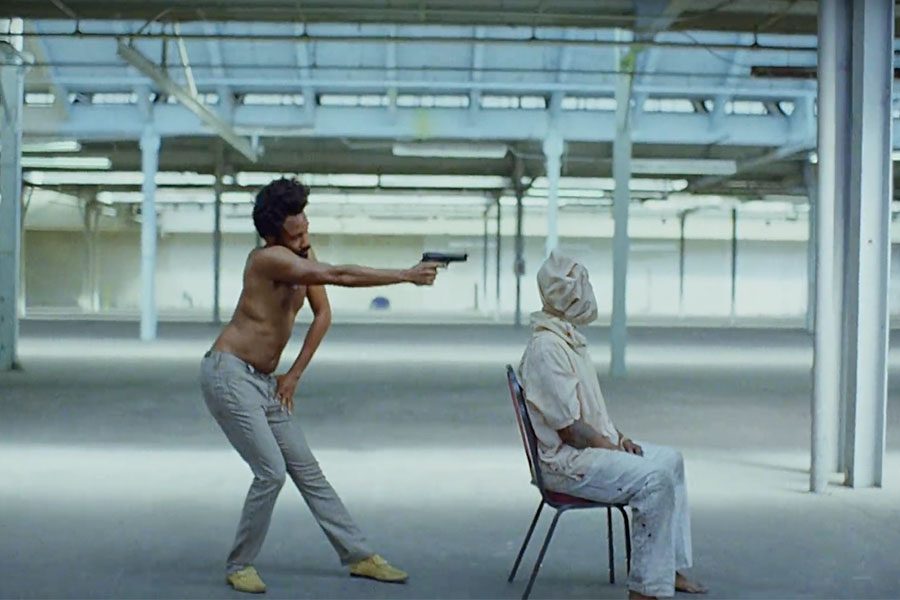Is This America?
May 10, 2018
Childish Gambino, also known as Donald Glover, is back with an explosive new song and music video that elegantly comments on race relations in America and reveals the black man’s plight in a remarkable light. This Is America is a satirical masterpiece. Gambino has shared his thoughts on the state of America through his public media interactions, which can be seen in songs of his like Riot and through the social rhetoric that is his TV show Atlanta. Glover caters to an audience of all races, but a surveyed student said, “The only ones that seem interested in it are people of color. Something [about] that is a little disappointing.”
Time and time again, he expresses his love and gratitude to be involved in and to be seen as an influencer in black culture. In This Is America, Gambino takes his platform and shows Black America’s reality and how it is clouded by what Americans know as “black culture,” while in reality, black culture is being in fear for your life every day.
Gambino suggests that Americans are so blind to the many issues that the black community faces that they only see what black Americans present to mainstream media: popular dance trends, mumble rap, and glorified crime. The video, containing multiple extended metaphors, portrays just how the system uses black people as Gambino “dances around” police brutality, media influence, and cultural exhaustion.
An anonymous student stated: “I believe it represents us as a society ignoring everything happening in America as we try to cover it up with more positive events that do not matter.” People have been making gifs and meme-ing several aspects of the music video, particularly the strange dance moves and facial expressions, ironically missing the point by encouraging a culture that ignores anything that is real, viewing the video purely for entertainment.
Here are some important theories surrounding the video:
- Gambino is dressed like a slave.
- Gambino makes odd faces throughout the video, and poses strangely as he shoots his first victim. This is a direct nod to Jim Crow, early 20th century blackface, and the demeaning portrayal of blacks in the media.
- Because of the busyness of the music video, you almost don’t notice that every time Gambino shoots someone, he ensures the guns used are taken care of (they are handled by another person and wrapped carefully with a red cloth) while the bodies of the victims are left there or dragged off.
- As Gambino throws shots at Lil Pump/soundcloud rap, which he believes masks the death and destruction plaguing society, the first Horseman of the Apocalypse rides past in the background, “holding elements related to death, conquest or at times, the Antichrist.”
- The video shows Gambino murdering a black man and 8 black choir members in two separate occurrences, where there are no visible consequences. However, when he is shown smoking weed, a group of white people chase after him.
- The lyrics “this is a celly, that is a tool,” is a comment on Stephon Clark, who was killed after the police mistook a cell phone in his pocket for a gun.
Many of these often scary and dark events are not noticed due to Gambino’s gimmicks: dance moves, eccentric facials, and the ensemble of kids dancing with him distract you from the violence and the message.
There are some not-so-obvious theories sprouting from the video and from the content of the song itself, one mentioning Jordan Peele’s phenomenon of the Sunken Place and others commenting on the role of black people in American culture. In the live performance on SNL, Daniel Kaluuya introduces Childish Gambino, ergo encouraging the theory that the end of the music video shows Gambino running through the Sunken Place, “an environment meant to represent” the mental oppression of African-Americans by white people, shown in “Get Out,” a film that Kaluuya stars in. Tre Johnson’s Rolling Stone’s article captures best what we are all wondering about the video’s ending: is it a reference to Get Out? Is he trying to escape his own mind? Or is he being hunted, “for revealing the truth about our country?” We wonder if, “his captors plan to return Glover to his scripted role in a culture where the black entertainer isn’t a mirror, but a toy.” The lyrics: “We just want to party, party just for you,” brings to mind whether or not black Americans are living for themselves, or living to entertain others. In the live version, the lighting design makes it appear as though Gambino is dancing in a cage.The live performance, featuring five young black dancers, begins with one of the dancers on his knees as the other dancers seem entirely unfazed; then one by one, they begin dancing, inspired by each other as red and blue lights flash around the stage. One of the dancers performs as the others throw money on him, possibly representing the black artists’ responsibility in American culture: to entertain and only entertain. The live performance ends with Gambino and the other dancers disappearing, leaving just one little girl dancing by herself cheerfully. Some theorize that the choir that Gambino murders are the victims of the Emanuel AME church.
Gambino’s work has also faced negative feedback. Some people believe that Gambino is being praised for addressing issues that artists like Beyonce and Kendrick Lamar have been talking about for years, and others are criticizing him because of comments he made in the late 2000’s about black women. Analysts argue that Gambino can’t make these claims about the black experience in America when he has ridiculed black people in the past.
When a survey was given to 30 students and they were asked whether they have seen the music video, 30% said “Yes,” 26.7% said “No, but [they] plan to,” and 43.3% said “No, and [they] don’t plan to.” 20 members of the survey were Caucasian, six were Black, two were Asian, one was Hispanic, and one preferred to not answer.
Conservatives also view it as just another piece of “liberal propaganda,” one stating the following: “[It’s] probably about some liberal image of equality or something lame like that.” Some haven’t heard of it all and don’t plan on watching it, as stated in our data.
Regardless of the many theories surrounding Donald Glover’s, the video was clearly made to be open for interpretation. Glover has not commented on anyone’s thoughts, so he is likely enjoying watching the ongoing commentary on what it means to be a Black American. What are your thoughts on the video and the song? Tweet us at @bjpatriotpages.



